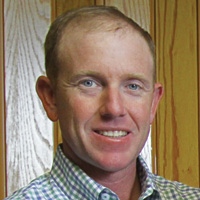Florida’s Cool Factor

 Travis Larson
Travis Larson
Okeechobee, Fla.
Larson is a third-generation dairy producer in southern Florida, milking 4,200 cows.
**Extended comments highlighted in blue.
The key to cow comfort in South Florida is keeping cows cool and udders dry as much as possible.
To accomplish this, we need to milk clean, dry cows and bed freestalls with clean, dry sand. We monitor, and adjust if necessary, our sprinkler systems daily for temperature, drift and performance. We also monitor cattle movement continuously to troubleshoot problem areas that may contribute to stress, lameness, excessive walking, etc.
The holding pen and shower barn give us the most "bang for our buck" when it comes to cooling cows. This is an area where all cows are effectively cooled (known amount of time, no outliers, etc.) before being milked in the parlor.
At Larson Dairy, 4' fans line the entire south end of the shower barn, pushing air north across the 40'-wide shower pen. The holding pen uses the same cross-ventilation plan to minimize fans while keeping cows cool and comfortable. We have eliminated overhead sprinklers in this area to prevent milking wet udders. Removing water from this area has also lengthened the life of some metal equipment. We are not replacing a rusted-out crowd gate every other year. So, now it is fans only for cooling cows from the shower pen to the parlor.
Rubber belting has become a key factor in improving cow comfort and reducing lameness. We use rubber belting in the holding area and parlor. We have also recently tacked a 3'-wide strip down the center of all our travel lanes. I can’t believe how well the cows use it. The cows will almost walk in a single-file line from their pen to the parlor to stay on the rubber belting instead of the grooved concrete.
Keeping clean, dry freestall beds is a must for cow comfort. Our pusher rakes out the back of each bed every time he brings a pen to be milked. We put new sand in at least one pen per day during dry weather.
During rainy weather or if the sand is wet, we fluff and groom beds daily. This year, a top herdsman suggested covering the stockpiled bedding sand with silage plastic. I was resistant because of the cost, but within a month of a trial-and-error period in August, during some rainy weather, I was a believer. Now we tarp our stockpiled sand with plastic, effectively keeping it dry and clean. The sand also cooks continuously inside the plastic under the intense sun. Tarping our sand has allowed us to bed clean, dry sand all summer and has drastically reduced our somatic cell count and the number of Klebsiella mastitis cases.
In the barns, we use a row of 4' fans spaced every 40' over the freestall beds. We also use the Edstrom box cooling system with soaker nozzles every 8' over the cows at the feed lanes.
Our sprinkler system works great as long as we do the required maintenance: changing filters, replacing leaking nozzles and repairing PVC damage. With the proper maintenance, sprinklers are an effective method to keep cows cool.
In our environment, cooling with sprinklers can add 5 lb. to 6 lb. of milk per day. However, missing nozzles, 30+ mph winds and poor maintenance can quickly make sprinklers more trouble than they are worth, especially if they’re soaking feedbunks and freestall beds.
We believe that with proper management and maintenance, our cow comfort strategies can be beneficial to the cows and profitable to our business.
| Larson's Most Recent Prices | |
| Milk (3.78% bf, 3.43% prt) | $21.07/cwt. |
| Cull cows | $75/head |
| Springing heifers | $1,600/head (delivered) |
| Cottonseed | $325/ton |
| Corn | $271/ton |
| Corn silage | $54.60/ton |
| Soybean meal | $592/ton |
| Citrus pulp | $174/ton |
| Distillers' grain | $249/ton |







